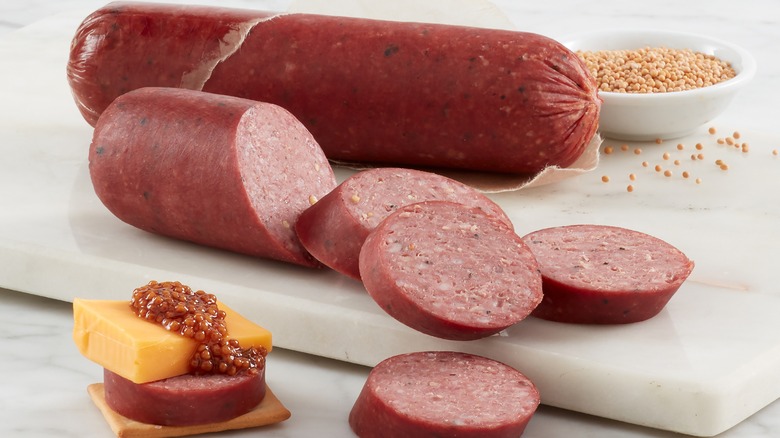Thuringer Is A Tangy German Sausage That Packs A Punch
The name may not sound familiar, but Thuringer (or Thüringer) is a type of sausage that's a must-try, especially if you're a tangy meats fan. Although it bears a name resembling a specific state in Germany –Thüringia– recognized for its unique take on bratwurst, Thuringer is dissimilar to the other well-known German sausages in the region.
The kind of Thuringer discussed here is closer to summer sausage. Moreover, it can often be found in American grocery aisles next to its cervelat relative, which is just another name for the various styles of semi-dried, fermented sausages. As Stanley and Adam Marianski's book, The Art of Making Fermented Sausage, explains, the name is pretty interchange since all three terms are "describing the same sausage."
However, regardless of whether or not the slightly-sour protein is comparable to its brethren, they still possess specific guidelines that pack a kick and define its composition. As a result, although Thuringer is similar to summer sausage, it's not quite the same. You may want to reconsider your expectations of what makes a terrific semi-dried sausage the next time you want a great addition to a charcuterie board.
How Thuringer differentiates itself from other sausages
While Thuringer-styled cervelat is in the same category as other semi-dried sausages, such as Pennsylvania's Lebanon bologna, it shares many characteristics with Thuringerian wursts, distinguishing it from others. Notably, it comes down to the spices used and the amount of fat it contains. For instance, the German sausage usually contains marjoram, caraway seeds, mustard seed, peppercorns, garlic, and occasionally lemon, and only has a fat content of 25 percent. Likewise, Thuringer summer sausage typically includes the same ingredients, particularly peppercorns (which manufacturers like Usinger's, an American company that makes this type of summer sausage, usually boast about when advertising) and roughly the same fat per serving, according to the United States Department of Agriculture.
However, what gives sausages like Thuringer their unmistakable but subtly tart punch is a production process that involves fermentation. As ground pork or beef is processed to create summer sausage, lactobacilli (a bacteria) is introduced as a culture starter, which lowers the meat's pH balance as the bacteria consume sugars and produce lactic acid. This procedure creates a noticeable sourness, which is also in other foods like sourdough, fermented vegetables (such as sauerkraut, pickles, and olives), and specific dairy products such as yogurt and certain cheeses. Still, in some cases, Thuringer takes it a step further, as Klement's — another American company that produces the product — explained to The Takeout. According to the company, the tanginess of their style of Thuringer is "due to a longer fermentation cycle."
Where to find Thuringer
Finding Thuringer can be easy or difficult, depending on where you're located. According to Klement's, Thuringer is considered a "hidden gem" that is hard to find outside of the Midwest and can usually only be found in places like Minnesota, Wisconsin, and North and South Dakota, which seems pretty on brand. After all, those areas have high German-descended populations, so sausage is a big part of the culture (the University of Minnesota even offers a course on making summer sausage).
However, even if you don't live near there, there's always the internet, and a quick search will give you many retailers and manufacturers. As a result, despite being unable to go to your local grocery store and pick up a tube, you still have the luxury of trying this delicious salty, mildly acidic treat. So, why not skip the summer sausage and grab its tastier cousin instead?


